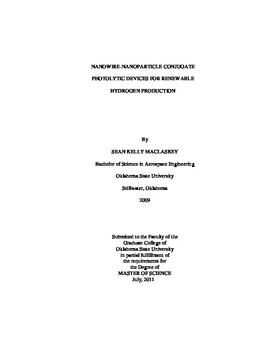| dc.contributor.advisor | Kalkan, A. Kaan | |
| dc.contributor.author | Maclaskey, Sean Kelly | |
| dc.date.accessioned | 2014-04-17T19:53:05Z | |
| dc.date.available | 2014-04-17T19:53:05Z | |
| dc.date.issued | 2011-07-01 | |
| dc.identifier.uri | https://hdl.handle.net/11244/9985 | |
| dc.description.abstract | A clean energy driven economy requires renewable production of zero-emission fuels, such as hydrogen (H2). Photocatalytic generation of H2 is one such method to fulfill this demand. Photocatalytic water splitting is an electrochemical process driven by solar energy to produce H2. Although there have been many investigations on photocatalytic water splitting, the number of concepts utilizing visible light is limited. In the present study, H2 evolution from water splitting is demonstrated using the novel concept of nanowire-;nanoparticle (NW-NP) conjugate devices irradiated by visible light. Photolytic nanodevice suspensions are fabricated via sol-;gel synthesis of vanadium oxyhydrate (V3O7�H2O) NWs, followed by solution chemistry with HAuCl4 for reduction of gold (Au) NPs on the NW surfaces. Characterization of nanodevices was performed via TEM, SEM, and optical spectroscopy. Products of photolysis were quantified and analyzed by Gas Chromatography (GC). The performance of the nanowire-;nanoparticle conjugate devices was compared with previous photolytic device designs by the use of quantum and internal conversion efficiencies (QE and ICE, respectively). The present thesis demonstrates photocatalytic production of H2 using V3O7�H2O NW -; Au NP conjugate devices under 470 nm excitation. The "photolytic nanodevice suspension in water" concept poses the potential for scalable H2 production, in addition to the provision for a low-;cost technique due to fabrication by sol-;gel synthesis and solution chemistry. The V3O7�H2O aerogel, a recently discovered semiconductor material, is found to be a suitable photoanode due to its narrow band gap energy of 2.18 eV, and its stability during photolysis. The diameters of the V3O7�H2O NWs are found to be 12 nm (�2.4 nm) from SEM images. The decoration of NWs with Au NPs is verified by TEM imaging and Au NPs are estimated to be 7.5 nm (�2.2 nm) in size. After decoration of NWs by Au NPs, a near-;field enhancement effect on optical absorption by NWs was observed by UV-visible spectroscopy. Further, the emergence of new optical absorbance peaks indicates possible coupling of incident light into waveguide modes of the NWs. QE and ICE values for the NW-NP conjugate devices are found to be 19.28% and 8.98%, respectively, for the first hour of photolysis. | |
| dc.format | application/pdf | |
| dc.language | en_US | |
| dc.publisher | Oklahoma State University | |
| dc.rights | Copyright is held by the author who has granted the Oklahoma State University Library the non-exclusive right to share this material in its institutional repository. Contact Digital Library Services at lib-dls@okstate.edu or 405-744-9161 for the permission policy on the use, reproduction or distribution of this material. | |
| dc.title | Nanowire-nanoparticle Conjugate Photolytic Devices for Renewable Hydrogen Production | |
| dc.type | text | |
| dc.contributor.committeeMember | Ausman, Kevin Douglas | |
| dc.contributor.committeeMember | Rubenstein, David | |
| osu.filename | Maclaskey_okstate_0664M_11516.pdf | |
| osu.college | Engineering, Architecture, and Technology | |
| osu.accesstype | Open Access | |
| dc.description.department | Mechanical & Aerospace Engineering | |
| dc.type.genre | Thesis | |
| dc.subject.keywords | hydrogen production | |
| dc.subject.keywords | nanotechnology | |
| dc.subject.keywords | nanowire | |
| dc.subject.keywords | photocatalysis | |
| dc.subject.keywords | water photolysis | |
